
Hieronymus Bosch was a Dutch painter from Brabant. He is one of the most notable representatives of the Early Netherlandish painting school. His work, generally oil on oak wood, mainly contains fantastic illustrations of religious concepts and narratives. Within his lifetime, his work was collected in the Netherlands, Austria, and Spain, and widely copied, especially his macabre and nightmarish depictions of hell.

Sabre Wulf is an action-adventure game released by British video game developer Ultimate Play the Game for the ZX Spectrum home computer in 1984. The player navigates the pith-helmeted Sabreman through a 2D jungle maze while collecting amulet pieces to bypass the guardian at its exit. The player does not receive explicit guidance on how to play and is left to decipher the game's objectives through trial and error. Sabreman moves between the maze's 256 connected screens by touching the border where one screen ends and another begins. Each screen is filled with colourful flora, enemies that spawn at random, and occasional collectibles.
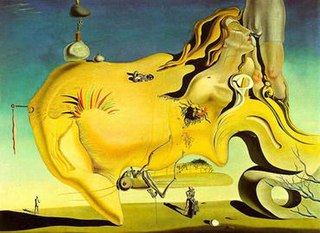
The Great Masturbator (1929) is a painting by Salvador Dalí executed during the surrealist epoch, and is currently displayed at Museo Nacional Centro de Arte Reina Sofía, Madrid.

The Garden of Earthly Delights is the modern title given to a triptych oil painting on oak panel painted by the Early Netherlandish master Hieronymus Bosch, between 1490 and 1510, when Bosch was between 40 and 60 years old. It has been housed in the Museo del Prado in Madrid, Spain since 1939.
Nocturnal Emissions is Nigel Ayers's sound art project that has released numerous records and CDs in music styles ranging from electro-acoustic, musique concrète, hybridised beats, sound collage, post-industrial music, ambient and noise music. Their sound art has been part of an ongoing multimedia campaign of guerrilla sign ontology utilizing video art, film, hypertext and other media, particularly collage. Nocturnal Emissions were depicted by the novelist Stewart Home.

Jumanji is a 1995 American fantasy adventure comedy film directed by Joe Johnston from a screenplay by Jonathan Hensleigh, Greg Taylor, and Jim Strain, based on the 1981 children's picture book of the same name by Chris Van Allsburg. The film is the first installment in the Jumanji film series and stars Robin Williams, Kirsten Dunst, David Alan Grier, Bonnie Hunt, Jonathan Hyde, and Bebe Neuwirth. The story centers on a supernatural board game that releases jungle-based hazards on its players with every turn they take.
Martha Clarke is an American theater director and choreographer noted for her multidisciplinary approach to theatre, dance, and opera productions. Her best-known original work is The Garden of Earthly Delights, an exploration in theatre, dance, music and flying of the famous painting of the same name by Hieronymus Bosch. The production was honored with a Drama Desk Award for Unique Theatrical Experience, an Obie Award for Richard Peaslee's original score, and a Los Angeles Drama Critics Circle Award for choreography.

Datamost was a computer book publisher and computer game company founded by David Gordon and based in Chatsworth, California. Datamost operated in the early 1980s producing games and other software mainly for the Apple II, Commodore 64 and Atari 8-bit computers, with some for the IBM PC. It also published educational and reference materials related to home computers and computer programming.
Earthly Delights may refer to:

Mr. Robot and His Robot Factory is a platform game created for Atari 8-bit computers by Ron Rosen and published in 1983 by Datamost. The music was composed by Gary Gilbertson using Philip Price's Advanced Music Processor, while the title screen was drawn by Art Huff. It was ported to the Apple II by Robert McNally and to the Commodore 64.

The Missing Ring is a role-playing video game written by Terry Romine for the Apple II and published in 1982 by Datamost.
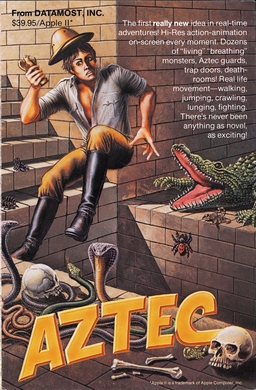
Aztec is an action-adventure game developed by Paul Stephenson for the Apple II and published by Datamost in 1982. It was ported to the Atari 8-bit computers and Commodore 64. In Aztec, the player enters and explores the recently discovered "Tomb of Quetzalcoatl" in Mexico in search of a jade idol.
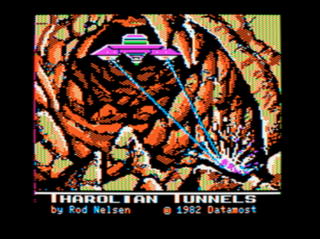
Tharolian Tunnels is a fixed shooter for the Apple II family of computers programmed by Rod Nelsen and published by Datamost in 1982. The game is similar to Space Invaders.

Dragons of Despair is the first in a series of 16 Dragonlance adventures published by TSR, Inc. (TSR) between 1984 and 1988. It is the start of the first major story arc in the Dragonlance series of Dungeons & Dragons (D&D) role-playing game modules, a series of ready-to-play adventures for use by Dungeon Masters in the game. This series provides a game version of the original Dragonlance storyline later told in the Dragonlance Chronicles trilogy of novels. This module corresponds to the events told in the first half of the novel Dragons of Autumn Twilight by Margaret Weis and Tracy Hickman. Its module code is DL1, which is used to designate it as the first part of the Dragonlance adventure series.

Tubeway is a video game for the Apple II programmed by David Arthur Van Brink and published by Datamost in 1983. It is similar to the 1981 Atari arcade game Tempest.
Non-games are a class of software on the border between video games and toys. The term "non-game game" was coined by late Nintendo president Satoru Iwata, who describes it as "a form of entertainment that really doesn't have a winner, or even a real conclusion". Will Wright had previously used the term "software toy" for the same purpose. The main difference between non-games and traditional video games is the lack of structured goals, objectives, and challenges. This allows the player a greater degree of self-expression through freeform play, since they can set up their own goals to achieve. Some genres that have been considered non-games include language-learning software, digital tabletop games, puzzle games, simulation games, and art games.
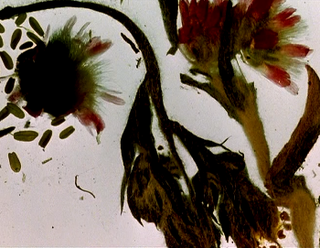
The Garden of Earthly Delights is an experimental short film by Stan Brakhage, released in 1981. The film was partly inspired by Hieronymus Bosch’s painting of the same name.
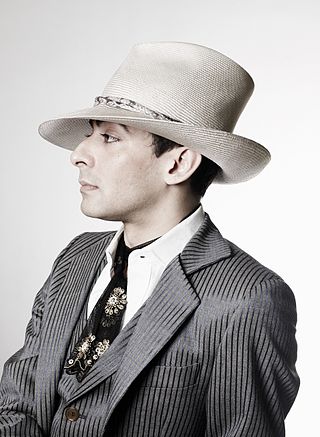
Raqib Shaw is a Kashmir-born, London-based artist. He is known for his opulent and intricately detailed paintings of imagined paradises, inlaid with vibrantly coloured jewels and enamel. His paintings and sculptures evoke the work of Old Masters such as Holbein and Bosch, whilst drawing on multifarious sources, from mythology and religion to poetry, literature, art history, textiles and decorative arts from both eastern and western traditions, all infused with the artist's imagination.

Cohen's Towers is a platform game written by Frank Cohen and released by Datamost in 1983 for Atari 8-bit computers and Commodore 64. It was re-released in 1986 by Databyte in the United Kingdom.
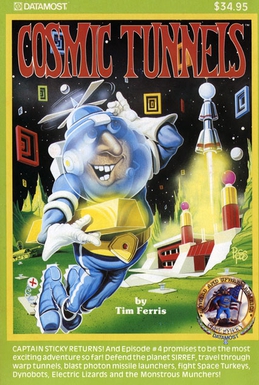
Cosmic Tunnels is a space-themed action game written by Tim Ferris and published by Datamost in 1983 for Atari 8-bit computers and in 1984 for the Commodore 64. Datamost also sold the game with Cohen's Towers as a "twin pack". It was re-released in 1986 by Databyte in the United Kingdom.
















